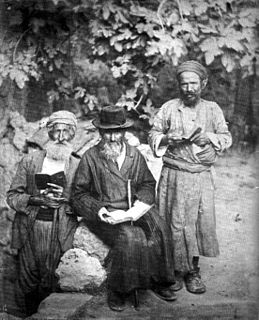Antisemitism is hostility to, prejudice towards, or discrimination against Jews. A person who holds such positions is called an antisemite. Antisemitism is considered to be a form of racism.

Sephardi Jews, also known as Sephardic Jews, Sephardim, or Hispanic Jews by modern scholars, are a Jewish ethnic division originating from traditionally established communities in the Iberian Peninsula. The term "Sephardim" also sometimes refers to Mizrahi Jews of Western Asia and North Africa. Although most of this latter group do not have ancestry from the Jewish communities of Iberia, the majority of them were influenced by the Sephardic style of liturgy and Sephardic law and customs from the influence of the Iberian Jewish exiles over the course of the last few centuries. This article deals with Sephardim within the narrower ethnic definition.

Crypto-Judaism is the secret adherence to Judaism while publicly professing to be of another faith; practitioners are referred to as "crypto-Jews".
Religious antisemitism is aversion to or discrimination against Jews as a whole, based on religious doctrines of supersession that expect or demand the disappearance of Judaism and the conversion of Jews, and which figure their political enemies in Jewish terms. This often has led to false claims against Judaism and religious antisemitic canards. It is sometimes called theological antisemitism.

The history of the Jews in Latin America began with conversos who joined the Spanish and Portuguese expeditions to the continents. The Alhambra Decree of 1492 led to the mass conversion of Spain's Jews to Catholicism and the expulsion of those who refused to do so. However, the vast majority of Conversos never made it to the New World and remained in Spain slowly assimilating to the dominant Catholic culture. This was due to the requirement by Spain's Blood Statutes to provide written documentation of Old Christian lineage to travel to the New World. However, the first Jews came with the first expedition of Christopher Columbus, including Rodrigo de Triana and Luis De Torres.

The history of the Jews in Greece can be traced back to at least the fourth century BCE. The oldest and the most characteristic Jewish group that has inhabited Greece are the Romaniotes, also known as "Greek Jews." The term "Greek Jew" is predominantly used for any person of Jewish descent or faith that lives in or originates from the modern region of Greece.

The Alhambra Decree was an edict issued on 31 March 1492, by the joint Catholic Monarchs of Spain ordering the expulsion of practicing Jews from the Crowns of Castile and Aragon and its territories and possessions by 31 July of that year. The primary purpose was to eliminate the influence of practicing Jews on Spain's large formerly-Jewish converso New Christian population, to ensure the latter and their descendants did not revert to Judaism. Over half of Spain's Jews had converted as a result of the religious persecution and pogroms which occurred in 1391. Due to continuing attacks, around 50,000 more had converted by 1415. A further number of those remaining chose to convert to avoid expulsion. As a result of the Alhambra decree and persecution in the years leading up to the expulsion, of Spain’s estimated 300,000 Jewish origin population, a total of over 200,000 had converted to Catholicism to remain in Spain, and between 40,000 and 100,000 remained Jewish and suffered expulsion. An unknown number of the expelled eventually succumbed to the pressures of life in exile away from formerly-Jewish relatives and networks back in Spain, and so converted to Catholicism to be allowed to return in the years following expulsion.:17

Moroccan Jews constitute an ancient community. Before the founding of Israel in 1948, there were about 250,000 to 350,000 Jews in the country, which gave Morocco the largest Jewish community in the Muslim world, but by 2017 only 2,000 or so remain. Jews in Morocco, originally speakers of Berber languages, Judeo-Moroccan Arabic or Judaeo-Spanish, were the first in the country to adopt the French language in the mid-19th century, and unlike the muslim population French remains the main language of members of the Jewish community there.

The history of the Jews in Turkey covers the 2400 years that Jews have lived in what is now Turkey. There have been Jewish communities in Anatolia since at least the fifth century BCE and many Spanish and Portuguese Jews expelled from Spain by the Alhambra Decree were welcomed into the Ottoman Empire in the late 15th century, including regions now part of Turkey, centuries later, forming the bulk of the Ottoman Jews.

Racial antisemitism is prejudice against Jews based on a belief or assertion that Jews constitute a distinct race or ethnic group that has inherent traits or characteristics that are in some way abhorrent or inherently inferior or otherwise different from that of the rest of society. The abhorrence may be expressed in the form of stereotypes or caricatures. Racial antisemitism may present Jews, as a group, as being a threat in some way to the values or safety of society. Racial antisemitism could be seen as worse than religious antisemitism because for religious antisemites conversion was an option and once converted the 'Jew' was gone. With racial antisemitism a Jew could not get rid of their Jewishness.

Trees Cry for Rain: A Sephardic Journey is a short documentary film by American documentary filmmaker Bonnie Burt that follows "America's Internet Champion of Ladino" Rachel Amado Bortnick, as she explores her Jewish-Turkish heritage and the vanishing world of Sephardic culture and the Ladino language. The film was officially released in 1989, but drew public attention in 1992 with screenings at a number of Jewish film festivals worldwide, including the San Francisco Jewish Film Festival and the Madrid "Festival de Cine Judio" which was dubbed "the biggest Jewish cultural event held in Spain in 500 years". This was followed by a public screening at the Lincoln Center for the Performing Arts in New York, and airing on The Jewish Channel.
Moroccan Jews are Jews who live or have lived in Morocco. A significant Jewish population migrated from Spain and Portugal, after the Spanish Inquisition, to the area and settled among Arab-Berbers. They were later met by a second wave of migration from the Iberian peninsula in the period immediately preceding and following the 1492 Alhambra Decree, when Jews were expelled from Spain, and soon after, from Portugal. This second immigration wave changed Moroccan Jewry, who largely embraced the Andalusian Sephardic liturgy, to switch to a mostly Sephardic identity.

Sol Hachuel was a Jewish heroine who was publicly decapitated when she was 17 years old. She was executed in 1834 for alleged apostasy from Islam—apparently without ever having converted to Islam. According to The Jewish Encyclopedia Hachuel "was a martyr to her faith, preferring death to becoming the bride of the sultan." She is considered a tzadeket (saint) by some Jews and is also revered by some Muslims. Jews call her Sol HaTzaddikah, while Arabs call her Lalla Suleika.

By the time the Ottoman Empire rose to power in the 14th and 15th centuries, there had been Jewish communities established throughout the region. The Ottoman Empire lasted from the early 14th century until the end of World War I and covered parts of Southeastern Europe, Anatolia, and much of the Middle East. The experience of Jews in the Ottoman Empire is particularly significant because the region "provided a principal place of refuge for Jews driven out of western Europe by massacres and persecution".
Sephardic Bnei Anusim is a modern term which is used to define the contemporary Christian descendants of an estimated quarter of a million 15th-century Sephardi Jews who were coerced or forced to convert to Catholicism during the 14th and 15th century in Spain and Portugal. The vast majority of conversos remained in Spain and Portugal, and their descendants, who number in the millions, live in both of these countries. The small minority of conversos who did emigrate normally chose to emigrate to destinations where Sephardic communities already existed, particularly to the Ottoman Empire and North Africa, but also to more tolerant cities in Europe, where many of them immediately reverted to Judaism. Although a few of them traveled to Latin America with colonial expeditions, doing so was particularly difficult, since only those Spaniards who could certify that they had no recent Muslim or Jewish ancestry were allowed to travel to the New World. But the constant flow of Spanish emigration to Latin America until well into the 20th century resulted in many Latin Americans having Converso ancestry, in the same way that many modern Spaniards do.
North African Sephardim are a distinct sub-group of Sephardi Jews, who descend from exiled Iberian Jewish families of the late 15th century and North African Maghrebi Jewish communities.

The textile industry became an important feature of 16th-century Safed, Ottoman Galilee, following an influx of Jewish immigration in late 15th and early 16th centuries. Run as a Jewish monopoly, textile manufacturing became the community's main source of income. The industry declined toward the end of the century.
Megorashim is a term used to refer to Jews from the Iberian Peninsula who arrived in North Africa as a result of the anti-Jewish persecutions of 1391 and the expulsion of Jews from Spain in 1492. These migrants were distinct from pre-existing North African Jews called Toshavim. The Toshavim had been present in North Africa since ancient times, spoke the local languages, and had traditions that were influenced by Maghrebi Islam. The Megorashim influenced North African Judaism, incorporating traditions from Spain. They eventually merged with the Toshavim, so that it is now difficult to distinguish between the two groups. The Jews of North Africa are often referred to as Sephardi, a term that emphasizes their Iberian roots and Iberian traditions.

Pamela S. Nadell is an American historian, researcher, author, and lecturer focusing on Jewish history. Former President of the Association for Jewish Studies, she currently holds the Patrick Clendenen Chair in Women's and Gender History at American University. Nadell has focused her research on Jewish women and their role within Jewish history as well as in shaping the history of the United States through their role in various social and political movements.

Adela Cojab Moadeb is an Israeli activist, public speaker, and author. Cojab is best known for her fight for Israel and fight against anti-Semitism on college campuses throughout the United States, and has frequently been recognized as a leading voice on these issues.














